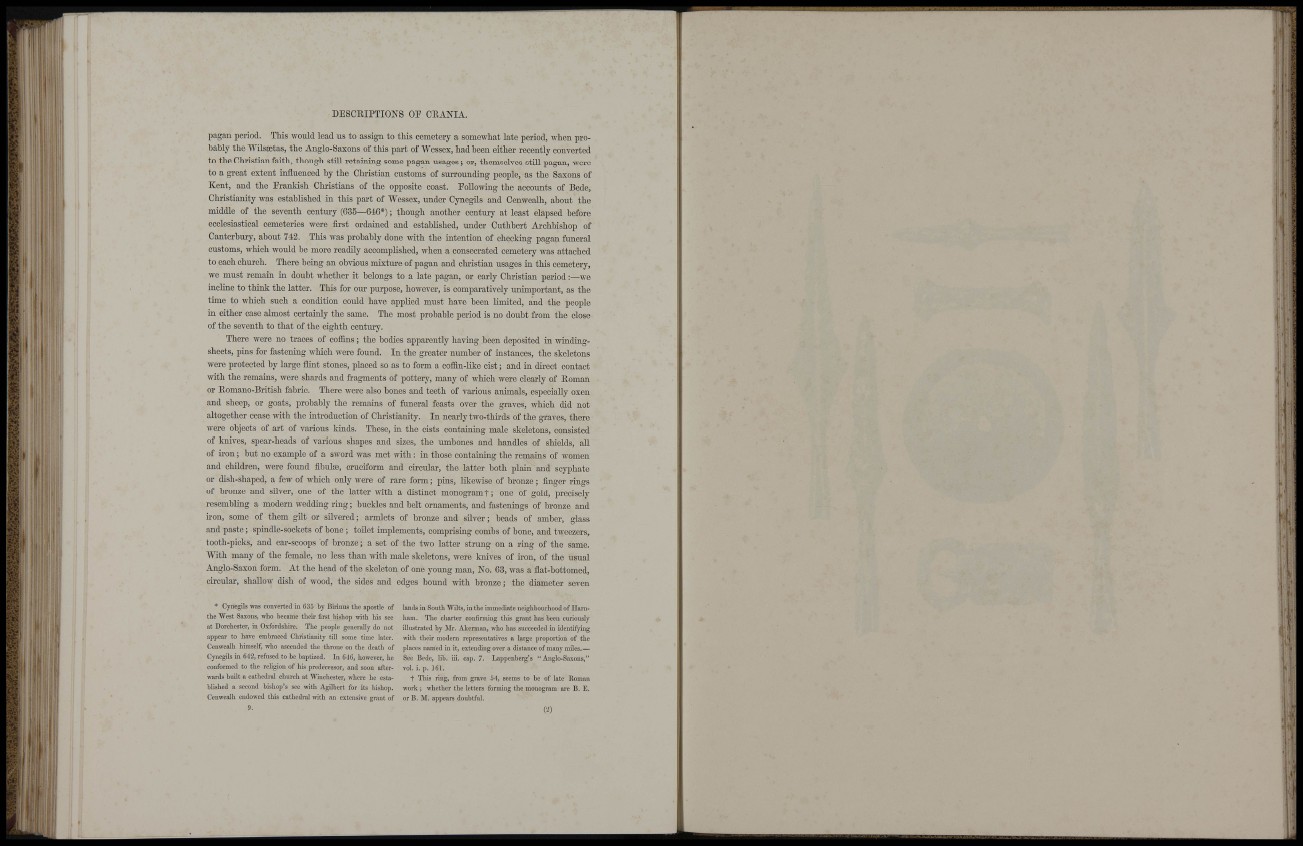
DESCRIPTIONS OE CRANIA.
pagan period. Tliis would lead us to assign to this cemetery a somewliat late period, when probably
the Wilsajtas, the Anglo-Saxons of tliis part of Wessex, had been either recently converted
to the Christian faith, though stiU retaining some pagan usages; or, themselves stiU pagan, were
to a great extent influenced by the Christian customs of surrounding people, as the Saxons of
Kent, and the EranMsh Christians of the opposite coast. PoUowing the accounts of Bede,
Christianity was established in this part of Wessex, under Cynegils and Cenwealh, about the
middle of the seventh century (635—646*); though another centui-y at least elapsed before
ecclesiastical cemeteries were fii-st ordained and established, under Cuthbert Ai-chbishop of
Canterbury, about 742. This was probably done with the intention of checking pagan funeral
customs, which would be more readily accomplished, when a consecrated cemetery was attached
to each church. There being an obvious mixtiu-e of pagan and christian usages in this cemetery,
we must remain in doubt whether it belongs to a late pagan, or early Christian period:—we
incline to think the latter. This for oui- purpose, however, is comparatively unimportant, as the
time to which such a condition could have appUed must have been limited, and the people
in either case almost certainly the same. The most j)robable period is no doubt from the close
of the seventh to that of the eighth century.
There were no traces of coffins; the bodies apparently having been deposited in windingsheets,
pins for fastening wliich were found. In the greater number of instances, the skeletons
were protected by large flint stones, placed so as to form a cofiln-like cist; and in dii-ect contact
with the remains, were shards and fragments of pottery, many of which were clearly of Roman
or Romano-British fabric. There were also bones and teeth of various animals, especially oxen
and sheep, or goats, probably the remains of funeral feasts over the graves, which did not
altogether cease with the introduction of Christianity. In nearly two-thirds of the graves, there
were objects of art of various kinds. These, in the cists containing male skeletons, consisted
of knives, spear-heads of various shapes and sizes, the umbones and handles of shields, all
of iron; but no example of a sword was met with: in those containing the remains of women
and childi-en, were found flbulie, cruciform and cii-oular, the latter both plain and scyphate
or dish-shaped, a few of which only were of rai-e form; pins, likewise of bronze; finger rings
of bronze and silver, one of the latter with a distinct monogram t ; one of gold, precisely
resembling a modern wedding ring; buckles and belt ornaments, and fastenings of bronze and
iron, some of them gilt or silvered; armlets of bronze and silver; beads of amber, glass
and paste; spindle-sockets of bone; toilet implements, comprising combs of bone, and tweezers,
tooth-picks, and eai--scoops of bronze; a set of the two latter strung on a ring of the same.
With many of the female, no less than with male skeletons, were knives of iron, of the usual
Anglo-Saxon form. At the head of the skeleton of one young man. No. 63, was a flat-bottomed,
circular, shallow dish of wood, the sides and edges bound with bronze; the diameter seven
* Cynegils was converted in 635 by Birinus the apostle of
the West Saxons, who became their first bishop with his see
at Dorchester, in Oxfordshire. The people generally do not
appear to have embraced Christianity till some time later.
Cenwealh himself, who ascended the throne on the death of
Cynegils in 642, refused to be baptized, In 046, however, he
conformed to the religion of his predecessor, and soon afterwards
built a cathedral church at Winchester, where he established
a second bishop's see with Agilbert for its bishop.
Cenwealh endowed this cathedral with an extensive grant of
9.
lands in South Wilts, in the immediate neighbourhood of Ilarnham.
The charter confirming this grant has been curiously
illustrated by Mr. Akerman, who has succeeded iu identifying
with their modern representatives a large proportion of the
places named in it, extending over a distance of many miles.—
See Bede, lib. iii. cap. 7. Lappenberg's "Anglo-Saxons,"
vol. i. p. 161.
f This ring, from grave 54, seems to be of late Roman
work ; whether the letters forming the monogram are B. E.
or B. M. appears doubtful.
C-i)
1i Ì -
r
M
f i q
t ¡i"
I